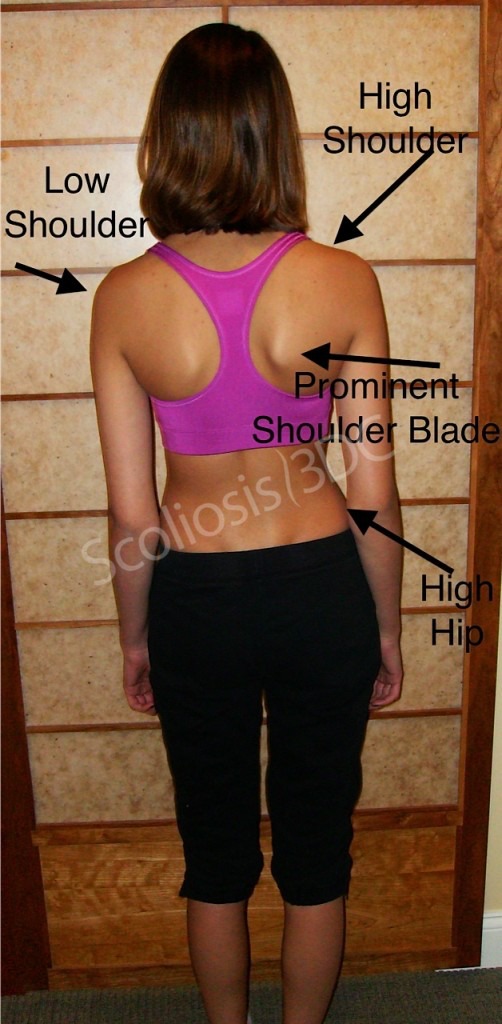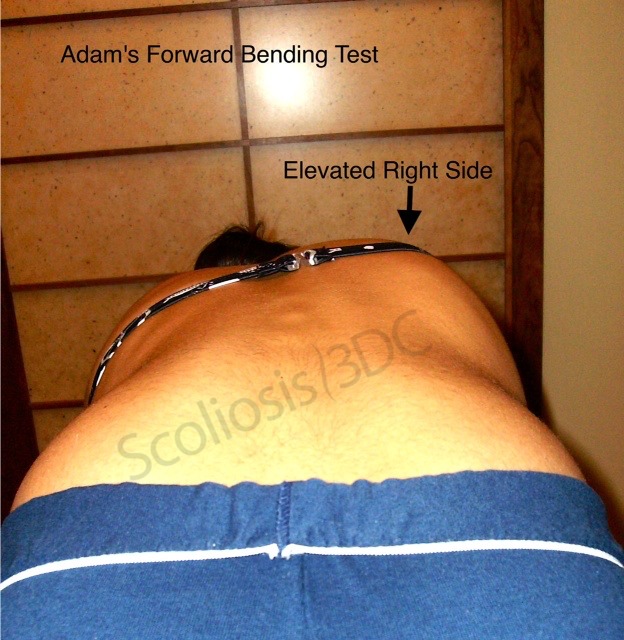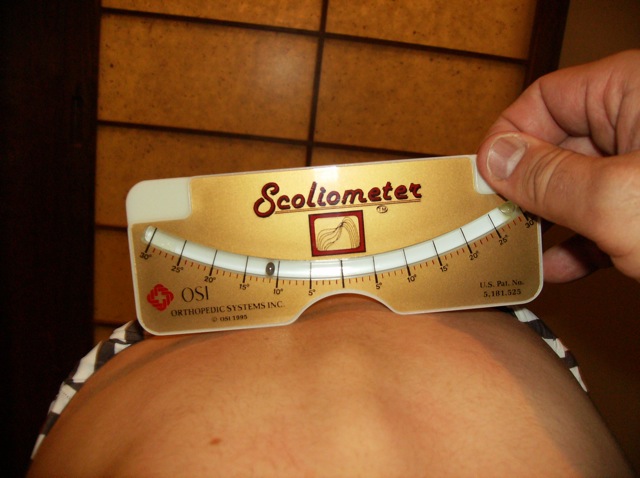Updated: February 3, 2025. Idiopathic scoliosis can appear without warning. Knowing the signs of scoliosis may help you detect an emerging curve so you can take action. Scoliosis is most often diagnosed during adolescence but if you have concerns, for example, due to family history, you may want to begin checking your children before adolescence.

Signs of Scoliosis
• Unlevel shoulders
• Unlevel hips, with or without hip prominence
• Head tilts off-center
• Head is not in line with the pelvis
• Rib prominences/trunk asymmetries
• Shoulder asymmetry
• Trunk asymmetry on forward bending
The most obvious sign of scoliosis is often a rib prominence on one side of the back as the patient bends forward. This happens because scoliosis is a three–dimensional condition of the spine and rib cage. With scoliosis, the spinal vertebra can rotate. This can cause the rib cage to be pulled out of alignment, toward the convex side. (The convex side of the curve is the side that shifts outward/sideways). This can create a prominence which is most notably seen when a child bends forward.

Right: Flat Sagittal Spine in a Scoliosis Patient
If you suspect scoliosis you may also want to look at your child from the side too. Does your child appear to have a very straight, flat back? Flattening of the spine in the sagittal plane can be an indication of an unstable spine. In some cases, this can be an early predictor of scoliosis in some cases (1).
Adam’s Forward Bend Test reveals signs of scoliosis
The Adam’s Forward Bend Test is often used to detect suspected scoliosis. It’s an observational test where the subject leans forward so the observer can view the back for spinal asymmetries. You can perform the test at home to start or see a professional.

If you opt to perform the test at home, have your child stand with their back facing you and then ask them to bend forward from the waist while keeping the feet together. Make sure the knees are straight and the arms are hanging down. On the forward bend, the spine should be parallel to the floor. Asymmetries (one side higher than the other at any point along the spine) could indicate scoliosis.
If you prefer to see a professional you can visit your pediatrician, a chiropractor, or school nurse for confirmation. These professionals can check your child’s spine with a Scoliometer™ – a small tool used to measure spinal rotation. A scoliometer™ is like a spinal level with a bubble in it, similar to the ones carpenters use during construction. It is a simple device that is placed over the patient’s back during the forward bend. When the trunk/spine is asymmetric, the bubble will shift to one side and the measurement will register in degrees of rotation.

If the Scoliometer™ reading is above 5º a spinal x-ray will help confirm scoliosis. (Many medical professionals use a 7º measurement; we prefer to err on the side of caution and use 5º because we always advocate for early detection so parents have the choice of being proactive!
A standing scoliosis X-ray series -PA and Lateral views can confirm scoliosis. That’s two views of the full spine, one from the back (PA), and one from the side (Lateral). A radiologist will report his/her observations regarding the X-rays. The report will hopefully include Cobb angle measurements (not always the case) for any scoliosis curvature. Cobb angle is also reported in degrees but NOT the same as the Scoliometer™ degrees reading. The referring doctor may measure the images as well. We recommend requesting a copy of the x-ray report, and CD with x-ray images to have for your records. A 10º Cobb angle, or more, indicates scoliosis.
Depending on what the x-rays show you may need to begin the decision-making process. Depending on who diagnoses scoliosis, most patients are referred to an orthopedic surgeon. You may or may not go this route depending on the measurements and degree of scoliosis.
We advocate proactive treatment for scoliosis. If your child is diagnosed with mild scoliosis, our mild scoliosis post will provide more information. We don’t agree with the observation-only philosophy for mild scoliosis. It’s one reason why our tagline is, “NOT WAIT AND SEE.” Unless you are lucky enough to have detected scoliosis when it is very, very mild and your child is almost at the end of growth we recommend you consider curve-pattern-specific exercise rehabilitation to help your growing child avoid scoliosis progression.
Parents who watch and wait only to see their child progress come to regret it. It’s happened to so many of our patients’ parents. Even the most sophisticated and medically astute parents. One of our patient’s moms is an M.D. from Maryland who followed the ‘watch and wait’ strategy. When her daughter’s scoliosis progressed, she called us to learn more about our Schroth program. On the call, she made the statement, “I feel like my profession has failed me.”
You should know that the onset of scoliosis is not always a gradual process. Sometimes scoliosis sneaks up and sometimes it comes on with a vengeance. Detecting scoliosis, of any severity, is upsetting! When Cobb angle indicates moderate or severe scoliosis we typically recommend taking a more aggressive non-surgical approach. To learn more about our methods of treating scoliosis you can click around our website to learn more or call us!
If you have a family history of scoliosis and you have more than one child, monitor all of your children for signs of scoliosis. We recommend doing this right through to Risser 5, skeletal maturity. When there is a family history of scoliosis, parents must be especially vigilant since researchers have indicated spinal curvature may have a genetic component. Scientists are working to identify the gene(s) that may play a role in scoliosis.
Please link to our diagnosis and evaluation blogs for scoliosis for more helpful information about scoliosis.
(1) http://www.bjj.boneandjoint.org.uk/content/50-B/1/24.long

